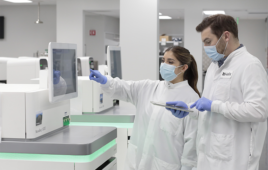Since the introduction of the clot-busting drug tPA more than a decade ago, evidence has been accumulating that tPA (tissue-type plasminogen activator) can be a double-edged sword for a brain affected by stroke. Although it remains the only FDA-approved treatment for acute stroke, tPA can also contribute to inflammation and brain cell damage.
Scientists at Emory University School of Medicine are testing strategies for blocking LRP1, a molecule that appears to transmit inflammation signals triggered by tPA. They have found that in mice, genetically removing LRP1 from certain brain cells called microglia softens tPA’s impact on the brain.
The results suggest that blocking tPA’s toxic effects could make it safer and allow doctors to use it more often on patients experiencing a stroke.
‘tPA is a protein released naturally by the body in response to a blood clot,’ says Manuel Yepes, MD, PhD, assistant professor of neurology at Emory University School of Medicine. ‘But it’s clearly not just lysing the clot.’
Doctors in community hospitals can often be reluctant to administer tPA to patients who appear to be having a stroke, Yepes says. One reason is that tPA has been shown to increase the risk of bleeding in the brain, he says.
Researchers have shown that tPA treatment increases the permeability of the blood-brain barrier, and that it can cross from the blood vessels into the brain tissue, generating inflammation. tPA targets cells called microglia, which are similar to white blood cells of the immune system, although they live in the brain.
‘Our strategy was to show that by blocking LRP1, you can prevent the inflammatory response to tPA,’ Yepes says. ‘This can be done either genetically, by deleting LRP1, or perhaps pharmacologically.’
Yepes and his colleagues are now testing a natural inhibitor of LRP1 called RAP in the laboratory. Co-treating or even pre-treating stroke patients with RAP might soften tPA’s effects.
Researchers had previously been unable to examine the effects of deleting LRP1, a protein involved in transporting cholesterol and other molecules around the brain, because mice completely lacking the gene die in the womb.
Yepes and his colleagues collaborated with Dudley Strickland, PhD, professor of surgery and physiology at University of Maryland School of Medicine, who provided mice deficient in LRP1 in macrophages (white blood cells) and microglia only.
The authors showed that the genetically altered mice have half the number of activated microglia in the brain after treatment with tPA. In addition, the volume of brain tissue damaged by a simulated stroke was cut in half in the genetically altered mice.
Release Date: January 23, 2009
Source: Emory University
Filed Under: Genomics/Proteomics




